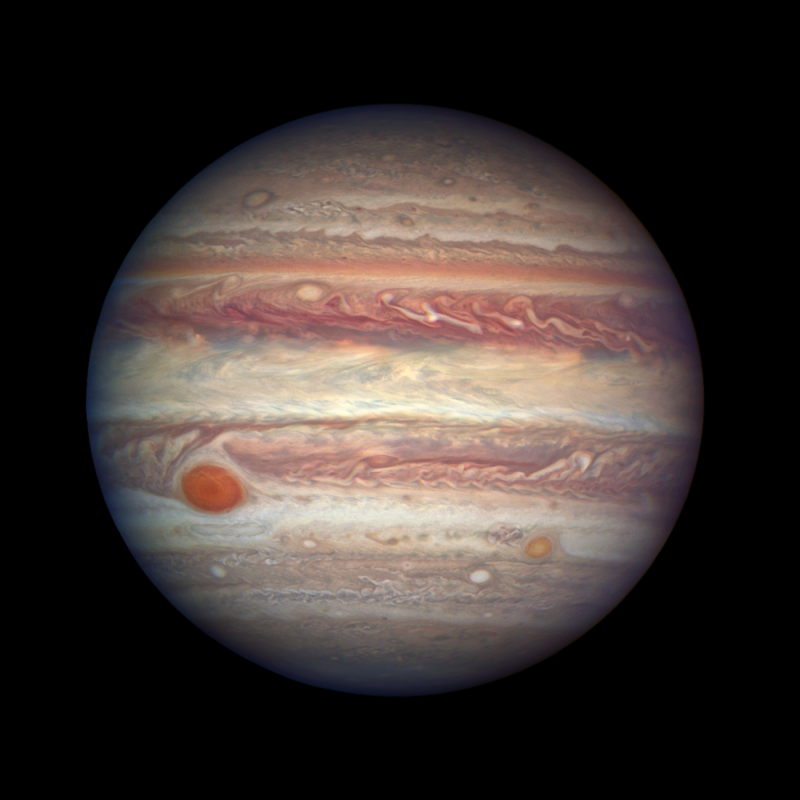Enjoy science and the beauty of the cosmos? Please donate to help EarthSky keep going.
Rather donate via PayPal or send a check? Click here.
Jupiter’s famous Great Red Spot is a vast and long-lived weather system on the giant planet, observed by astronomers since the first telescopes were aimed skyward in the 1600s. And Jupiter has small smaller spots or ovals, too, smaller storms that can last as little as a few hours or stretch on for centuries. Now astronomers say they’ve discovered another spot on Jupiter – dubbed the Great Cold Spot – that rivals as the planet’s Great Red Spot in size. It’s a dark spot, a cold spot, possibly driven by powerful energies from the auroras at Jupiter’s poles.
Tom Stallard is an associate professor at the University of Leicester in the UK and lead author of the new study, which was published April 11, 2017 in the peer-reviewed journal Geophysical Research Letters. Stallard said in a statement:
The Great Cold Spot is much more volatile than the slowly changing Great Red Spot, changing dramatically in shape and size over only a few days and weeks, but it has re-appeared for as long as we have data to search for it, for over 15 years. That suggests that it continually reforms itself, and as a result it might be as old as the aurorae that form it – perhaps many thousands of years old.

Astronomers describe the Great Cold Spot as a localized dark spot, up to 14,913 miles (24,000 km) in longitude and 7,456 miles (12,000 km) in latitude, in Jupiter’s thin high-altitude thermosphere. The spot is about 360 degrees Fahrenheit (200 degrees Celsius) cooler than the surrounding atmosphere.
They said they used the CRIRES instrument on the Very Large Telescope (VLT) in northern Chile to observe Jupiter. Their observations consisted of tracking:
… spectral emissions of H3+, an ion of hydrogen present in large amounts in Jupiter’s atmosphere.
These observations allowed the scientists to map the mean temperature and density of the planet’s atmosphere, and, in this way, they began to suspect the existence of a Great Cold Spot.
The researchers then searched for it in past observations. Jupiter’s infrared aurora was studied in detail by NASA’s InfraRed Telescope Facility (IRTF) for six years between 1995-2000, in preparation for the last mission to visit Jupiter, Galileo. These extensive observations resulted in a huge set of images of Jupiter, with more than 13,000 images taken over more than 40 nights. The astronomers combed through these past images – combining them with their recent research – and revealed the presence of the Great Cold Spot as an area of darkness within the hot environment of Jupiter’s upper atmosphere.

Stallard said:
What is surprising at Jupiter is that, unlike weather systems on Earth, the Great Cold Spot has been observed at the same place across 15 years. That makes it more comparable to weather systems in Jupiter’s lower atmosphere, like the Great Red Spot.
Observations and modelling of Earth’s upper atmosphere have shown that, on the short term, there may be changes in the temperature and density of the upper atmosphere.
The two main differences are, firstly, that Earth’s aurora sees dramatic changes caused by activity from the sun, whereas Jupiter’s aurora are dominated by gases from the volcanic moon Io, which are relatively slow and steady, and, secondly, that the atmospheric flows generated by Earth’s aurora can drive heat quickly across the whole planet, making the upper atmosphere ring like a bell, while Jupiter’s fast spin traps this energy nearer the poles.

Stallard added:
The detection of the Great Cold Spot was a real surprise to us, but there are indications that other features might also exist in Jupiter’s upper atmosphere. Our next step will be to look for other features in the upper atmosphere, as well as investigating the Great Cold Spot itself in more detail.
The Juno spacecraft is currently in orbit around Jupiter and the observations of Jupiter’s aurora and upper atmosphere by the JIRAM instrument that have been released so far already provide a wealth of new information about the planet.
When combined with our ongoing campaign of observations using telescopes on Earth, we hope to gain a much better understanding of this weather system in the next few years.

Bottom line: Astronomers have discovered a second Great Spot on Jupiter. It’s a Great Cold Spot, created by the powerful energies exerted by the planet’s polar aurorae that rivals the scale of Jupiter’s Great Red Spot.
Read more from AGU.
Enjoy science and the beauty of the cosmos? Please donate to help EarthSky keep going.











